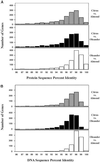Whole-genome comparative analysis of three phytopathogenic Xylella fastidiosa strains
- PMID: 12205291
- PMCID: PMC129457
- DOI: 10.1073/pnas.132393999
Whole-genome comparative analysis of three phytopathogenic Xylella fastidiosa strains
Abstract
Xylella fastidiosa (Xf) causes wilt disease in plants and is responsible for major economic and crop losses globally. Owing to the public importance of this phytopathogen we embarked on a comparative analysis of the complete genome of Xf pv citrus and the partial genomes of two recently sequenced strains of this species: Xf pv almond and Xf pv oleander, which cause leaf scorch in almond and oleander plants, respectively. We report a reanalysis of the previously sequenced Xf 9a5c (CVC, citrus) strain and the two "gapped" Xf genomes revealing ORFs encoding critical functions in pathogenicity and conjugative transfer. Second, a detailed whole-genome functional comparison was based on the three sequenced Xf strains, identifying the unique genes present in each strain, in addition to those shared between strains. Third, an "in silico" cellular reconstruction of these organisms was made, based on a comparison of their core functional subsystems that led to a characterization of their conjugative transfer machinery, identification of potential differences in their adhesion mechanisms, and highlighting of the absence of a classical quorum-sensing mechanism. This study demonstrates the effectiveness of comparative analysis strategies in the interpretation of genomes that are closely related.
Figures



References
-
- Purcell A. H. (1997) J. Plant Pathol. 79, 99-105.
-
- Mircetich S. M., Lowe, S. K., Moller, J. W. & Nyland, G. (1976) Phytopathology 66, 17-24.
-
- Davis M. J. & Thompson, S. V. (1980) Phytopathology 70, 472-475.
-
- Purcell A. H., Saunders, S. R., Hendson, M., Grebus, M. E. & Henry, M. J. (1999) Phytopathology 89, 53-58. - PubMed
Publication types
MeSH terms
Substances
Associated data
- Actions
- Actions
LinkOut - more resources
Full Text Sources
Other Literature Sources

